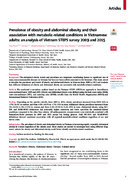Prevalence of obesity and abdominal obesity and their association with metabolic-related conditions in Vietnamese adults: an analysis of Vietnam STEPS survey 2009 and 2015
| dc.contributor.author | Pham, Tung | |
| dc.contributor.author | Bui, Linh | |
| dc.contributor.author | Giovannucci, Edward | |
| dc.contributor.author | Hoang, Minh | |
| dc.contributor.author | Tran, Bao | |
| dc.contributor.author | Chavarro, Jorge | |
| dc.contributor.author | Willett, Walter | |
| dc.date.accessioned | 2025-05-23T19:41:18Z | |
| dc.date.available | 2025-05-23T19:41:18Z | |
| dc.date.issued | 2023 | |
| dc.identifier.uri | https://vinspace.edu.vn/handle/VIN/632 | |
| dc.description.abstract | Background The abdominal obesity trends and prevalence are important contributing factors to significant rise of many noncommunicable diseases in Vietnam but have not been well-documented in the literature. This study aimed to describe the prevalence and trends of obesity and abdominal obesity in Vietnam from 2009 to 2015 and evaluate how different definitions of obesity and abdominal obesity are associated with metabolic-related conditions. Methods We conducted a secondary analysis based on the Vietnam STEPS (STEPwise approach to Surveillance) cross-sectional Survey 2009 and 2015. Obesity and abdominal obesity were defined using the body mass index (BMI), waist circumference (WC), and waist-hip ratio (WHR) cut-offs from the World Health Organization (WHO) and International Diabetes Federation (IDF). Findings Depending on the specific cut-offs, from 2009 to 2015, obesity prevalence increased from 0.8%–10% to 1.7%–16.4% in women and from 0.8%–10.3% to 1.7%–15% in men; abdominal obesity prevalence increased from 3%–31.3% to 8%–41.7% in women and from 0.3%–19.3% to 0.4%–25% in men. Abdominal obesity using WC-IDF and WHR-WHO definitions had noticeably higher sensitivity and lower specificity for metabolic-related conditions compared to the other four criteria. All anthropometric measurements were statistically correlated with biomarkers/blood pressure in 2009 and 2015 except for fasting glucose. Only WC-IDF and WHR-WHO definitions showed consistent association with all reported metabolic-related conditions regardless of sex and survey years. Interpretation The prevalence of obesity and abdominal obesity in Vietnam is increasing rapidly, especially abdominal obesity in women regardless of the criteria used. More studies are needed to investigate how using different diagnostic criteria for obesity and abdominal obesity could better identify metabolic-related conditions. Funding Authors received no funding for this study. | en_US |
| dc.subject | prevalence | en_US |
| dc.subject | obesity | en_US |
| dc.subject | abdominal obesity | en_US |
| dc.subject | vietnam | en_US |
| dc.subject | national survey | en_US |
| dc.title | Prevalence of obesity and abdominal obesity and their association with metabolic-related conditions in Vietnamese adults: an analysis of Vietnam STEPS survey 2009 and 2015 | en_US |
| dc.type | Article | en_US |
Các tập tin trong tài liệu này
Tài liệu này xuất hiện trong Bộ sưu tập
-
Pham Thanh Tung, MD, PhD. [2]
College of Health Sciences; Assistant Professor of Epidemiology/Global Health/Public Health

